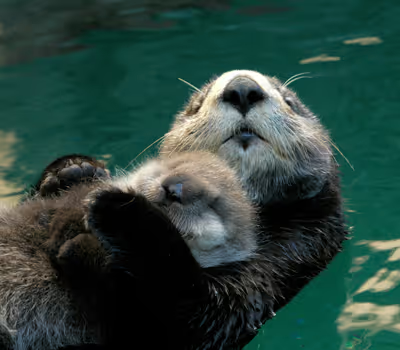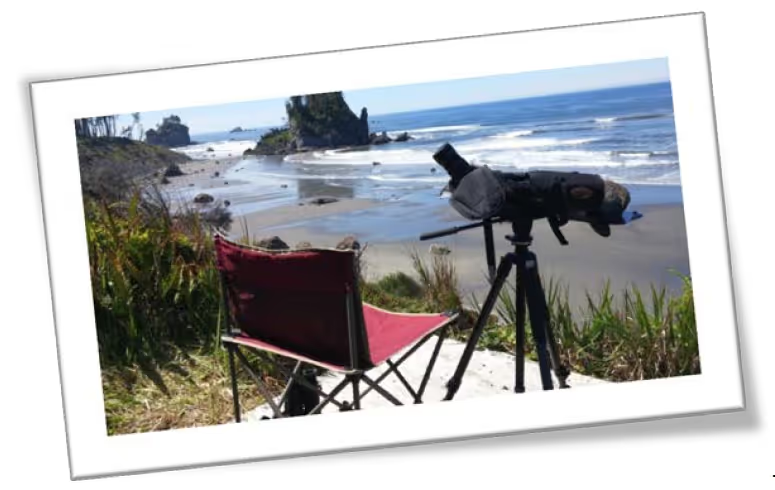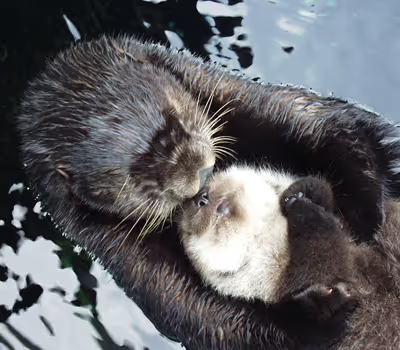The Adventure Of Sea Otters



Remember the song "Muskrat Love?" Some of us do. Written and recorded by Willis Alan Ramsey in 1972, covered by the band America in 1973, and made a bigger hit by Captain and Tennille in 1976, the song anthropomorphized two muskrats, Susie and Sam, and their romantic encounter. You either loved it or hated it!
I don’t know much about muskrats, and they are a much different aquatic mammal from a sea otter, being about a tenth of the size and living in rivers instead of oceans among other things. But I do think there should be a song about sea otters, and sea otter behavior looks so human it would be very difficult not to anthropomorphize extensively!
Why am I even thinking about this? I will explain. In June I got to pretend to be a wildlife biologist for three days, observing a site known to be frequented by sea otters and recording what I saw. During this welcome respite from my usual computer job I also boned up on sea otter lore.
Once upon a time, sea otters (Enhydra lutris kenyoni here in the north) were plentiful along the Eastern Pacific Coast. The Washington population was hunted to extinction (the dense beautiful fur, up to 1 million hairs per square inch, was extremely valuable in early trading years). In 1911, the International Fur Seal Treaty began protecting them from hunting, but by then only some of the Alaska population and a tiny number in California (E. lutris nereis, southern subspecies) had survived.
The 1960s saw some conservation efforts begin, and some Alaska sea otters were translocated to southern sites. In 1969 and 1970, fifty-nine sea otters were flown from Amchitka Island, Alaska to the Washington coast. This effort succeeded in restoring the population, which in the Olympic National Marine Sanctuary now numbers around 500. Washington still, however, lists the sea otter as an endangered species, and it is protected under the Marine Mammal Protection Act

The geology of the Washington Coast prevents sea otters from living between the Quinault River and the Columbia River, understandable when you realize their habitat needs are rocky shallows. My observation site was on a bluff above the beach, with a big rock pile directly west just below the low tide mark and small rocky islands to the north and south. It was prime habitat, with a kelp bed running outside the rock pile and the island to the south. My days were lucky too, due to mild overcast weather excellent for visibility and because three sea otters were hanging out in the area. It seemed like home.
I could make out the sea otters with my naked eye, but to see any kind of detail I needed binoculars or, better yet, a nice big spotting scope. Having been provided with that, I learned to identify male from female and make out what they were feeding on. The female had some wounding on her face, which occurs sometimes during mating, and the fur on her head was lighter in color from the other sea otters. She earned the nickname "Blondie," and was happy to be in the area all three days. Her frequent companion was a male we called "Studley."
Moving between the ocean bottom, where they find their food, and the ocean surface, where they rest and groom, sea otters spend nearly all of their time in the water. Kelp beds provide forage area, hiding urchins, crabs, clams, and some fish from other predators. Sea otters use rocks and their sharp front claws to dislodge prey and open shells. I observed Studley come up to the surface with an octopus the size of his head. He wrestled the octopus on his chest, devoured it tentacle by tentacle, and then ate the canteloupe-sized rest of it too, while paddling on his back slowly south, away from the other otter. Not into sharing that meal!
Sea otters must constantly groom their fur in order to preserve its insulating qualities. Not having a layer of blubber like other marine mammals, they keep warm by eating 25 to 30 percent of their body weight per day and keeping their fur coat clean. The grooming consists of ruffling, licking, and rolling in the water. It looks like somersaults, head over tail at the surface of the water, and Blondie spent most of her time doing this.
When Studley came to visit, it seemed like they kept about a ten-foot distance from each other. They floated there together for a good portion of the first two days, grooming themselves and feeding, riding the surf waves. On the third day, though, they interacted more. They ruffled each other’s heads, and when Studley would float away, Blondie would reach her front paws out to him. (Hence my mental connection to "Muskrat Love.") Sea otters are semi-social animals, and are known to float rafted together in groups, usually females and pups together and males separate. Sometimes otters will wrap themselves in a "head" of kelp to rest. Mothers might wrap their pup in kelp to keep it in one place while she forages. Pups have a layer of baby fur that retains so much air that the pup can’t dive, but bobs around on the surface like a cork. It takes several weeks for a pup to learn to dive. Most are weaned by eight months.
The third sea otter I observed appeared at the far edge of the kelp bed, and it kept moving. I wasn’t able to know much about it. Perhaps it didn’t want to enter what was obviously another otter’s territory. When traveling, sea otters swim on their bellies, with a rolling up-and-over motion. From a distance it is hard to tell if you are seeing an otter or a harbor seal or sea lion. I became accustomed to the head shape and motion patterns, though, so could pick out the harbor seal’s more stationary, upright head position. And when the otters are on their backs, their hind feet stick up out of the water making a unique profile.
Sea otters are mustelids, related to badgers, weasels, ferrets, wolverines, minks, and otters, the largest family in the order Carnivora. Muskrats are in the order Rodentia, so belong taxonomically with the squirrels, chipmunks, gophers, rats and mice. Humans seem to have a need to judge animals and deem some cuter and cuddlier and others uglier and less desirable. I know better, but I can’t help but rank sea otters right up there with puppies for cuteness. In any case, I was content to have observed a piece of Blondie’s and Studley’s summer. I hope they live long and prosper. And come on, all you musicians, somebody write a song"


© Virginia Molenaar, July 2015
Photos by C. J. Casson - Seattle Aquarium
Touch whale bones, examine shipwreck artifacts and connect with the coast's living history.

Support our mission, get involved in educational programs, or contribute through donations and volunteering.